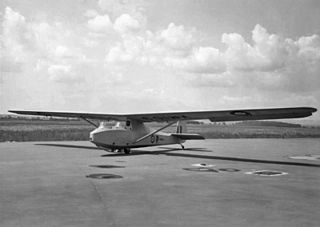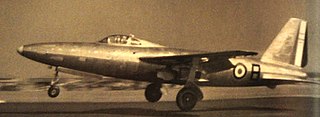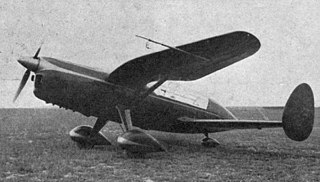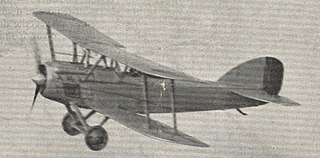
The Ambrosini Sagittario was an Italian aerodynamic research aircraft based on the manufacturer's S.7.

The wing configuration of a fixed-wing aircraft is its arrangement of lifting and related surfaces.

The Yakovlev Yak-1000 was a Soviet supersonic technology demonstrator intended to evaluate the aerodynamic layout and field performance of the cropped delta wing discussed in captured German documents in combination with the new Lyulka AL-5 turbojet. The tandem undercarriage proved to be unsatisfactory and there were serious flight stability problems related to the delta wing, enough so that it never flew after an accident during taxiing tests.

The Tipsy B was a small sports two-seat monoplane designed by Ernest Oscar Tips, and built in both Belgium and the UK. A total of 42 was built, and a few are still flying.

The Slingsby T.24 Falcon 4 was a two-seat training glider designed in the UK just after World War II for ATC use. It was judged too expensive for production and only three were completed.

The SNCASO SO.9000 Trident is a French mixed-power interceptor aircraft built by aircraft manufacturer SNCASO during the 1950s. As part of a wider effort to re-build French military power during the late 1940s and to furnish France with advanced, new domestically produced designs, a request for a supersonic-capable point-defence interceptor aircraft to equip the French Air Force was issued to SNCASO. In response, the firm designed the mixed-propulsion Trident, powered by a single SEPR rocket engine, which was augmented by wingtip-mounted turbojet engines, and the Air Force ordered two prototypes.

The Payen Pa 49 Katy was a small experimental French turbojet powered tailless aircraft, designed by Nicolas Roland Payen, and first flown in 1954. It was the first French aircraft of this kind and the smallest jet aircraft of its day.
The SIPA S.300 was a French turbojet powered basic trainer, claimed to be the first of its kind anywhere. Only one was built, the prototype crashing after a year's development.

The Mauboussin M.40 Hémiptère was an experimental, single seat, single engine light aircraft with unequal span tandem wings, designed in France in the 1930s. Only one was built.
The Eurofly FB5 Star Light is a single engine kit built Italian ultralight, seating two side by side. It first flew in the late 2000s.
The Procaer Cobra was a two-seat turbojet powered light aircraft designed and built in Italy and flown in the early 1960s. Only one was completed.
The Merville SM.31 is a French high performance glider with a laminar flow wing, first flown in 1960. Only one was built.

The Sud-Ouest SO.6020 Espadon (Swordfish) was a French post-war prototype interceptor designed and built by SNCASO during the late 1940s. The French Air Force judged the design a failure despite some records being set and cancelled plans to put it into service in 1951. Only four aircraft were built and they were later modified to serve as testbeds for the mixed rocket and turbojet-powered SNCASO SO.9000 Trident program. Only one badly damaged aircraft survives.
The Caudron C.251 Et-2 was a French tandem seat, open cockpit biplane designed as an intermediate trainer and built in 1931. It did not go into production.

The Delanne 20-T was a French tandem wing aircraft designed as an aerodynamic model for a larger fighter aircraft. It was tested during 1939.

The SFCA Lignel 10 was a French single seat aircraft designed to bridge a training gap between basic trainers and front-line fighters. The military requirement was soon dropped and only one was built.

The Astra-Protopopescu or Astra-Proto was a Romanian reconnaissance aircraft flown and tested in 1925.
The Caudron C.580 was a French advanced trainer aircraft intended to prepare pilots for the new low wing monoplane fighters of the mid-1930s. It did not go into production and only two were built.
The CPA 1 was a French twin-engined, parasol-winged bomber designed and built in the mid-1920s.

The Rubik R-03 Szittya I was a Hungarian single-seat sailplane flown in the late 1930s. The design was developed through three improving variants. though only one of each was built.













